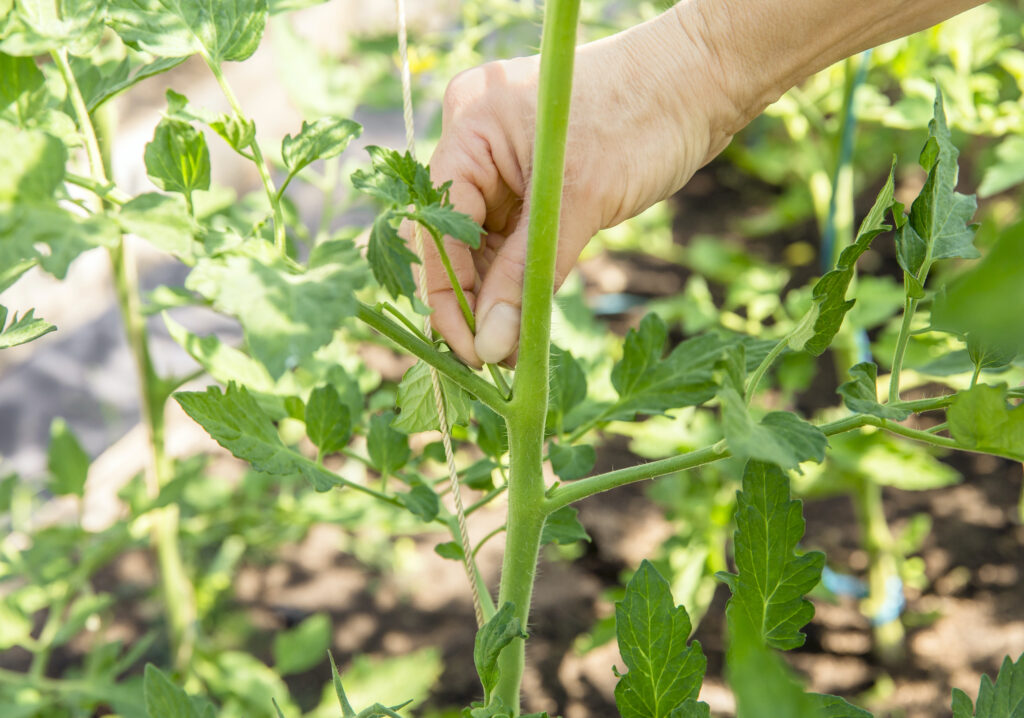This post may contain affiliate links. Please read our disclosures for more information.

When it comes to growing a vegetable garden, most people have a pretty accurate and straightforward idea of how to do it. Start the seed, plant it in the sun, water it, and watch it grow.
But what a lot of people miss, especially when they’re just getting started with a first garden, is the need for pruning their plants.
Yes, while letting your garden run wild and free technically is a perfectly acceptable method to being a gardener and raising fresh produce for your family, pruning vegetable plants is one of the tiny, overlooked keys to taking your skills (and your harvest potential) to the next level.
But before you go running to the garden with scissors, it’s important to make sure you understand pruning as more than arbitrarily cutting off a leaf here or a branch there. In this article, we’ll take a look at a high-level overview of why you should prove, when to prune (and which plants!), and the basics of how to prune.
For information about pruning specific plants, you can consult our ever-growing library of growing guides.
Table of Contents
Why Should You Prune Vegetables?
Most people believe that planting a vegetable plant and letting it grow is enough to get fresh produce for their families. And they’re 100% right.
But what if you could take that harvest and increase it? What if you could take that produce and make it better and sometimes even make it bigger?
That’s part of what pruning does for you. But that’s not all. Let’s look at the top, most common reasons for pruning vegetables in the garden.
Increased Yields
One of the first and foremost reasons why the best gardeners prune vegetables is to shift where the plants allot energy. Rather than growing extra branches that aren’t needed, for example, why not put that energy into another flower bud, or a bigger tomato?
Most commonly, you’ll find pruning either forces plants to grow the existing fruits larger (that energy had to go somewhere) or to put out more buds and grow a higher quantity of fruit.
As a homesteader, if you have the choice between an extra set of leaves on your plant or an extra tomato, it’s almost no contest!
Healthier Plants
Pruning, while yes a secret weapon to get more from each plant, is also a key way in keeping your plants healthy enough to actually make good on giving you more.
Leaves left close to the ground (which is common, for example, with tomato plants) can be splashed by wet soil during rains. This potentially introduces bacteria, spores, or other microscopic parasites, bugs, etc onto the leaves of the plant.
Just like it takes extra energy for your body to fight off potential invaders, the same is true for plants. Instead of your plant worrying about those leaves, do it a favor and snip them off. If they can’t get splashed, they can’t become a problem.
Easier Harvests
It’s not just the size of your harvests that improves when the plant can redirect energies into fruits instead of unnecessary extra leaves. With fewer branches or leaves going this way and that, you’ll simply put have a much easier time getting your hands all the way in to get to those veggies you worked so hard to grow!
It’s also a side benefit that with a cleaner space to hang, you’ll less likely to have gunk from wet/decaying leaves or bugs on the fruit itself…or at the very least you’ll see it before you put your hand on it!
And to go full circle — the easier it is to harvest, the more ripe veggies you’ll remove (instead of missing some), which often means the more energy the plants can redirect into more buds and thereby more veggies! Remember this: easier harvests make for more frequent harvests, and more frequent harvests make for more total harvest. Typically.
Better Sun Exposure
Whether you’re gardening by the square foot method and have short plants close by, or whether you’re standing amidst a forest of tomato plants, the more sun that can reach through to the soil, the better.
On the one hand, yes sun will increase the drying of the soil. You’ll have to watch watering and moisture levels a little more carefully.
But on the other hand, tomatoes ripen faster in the sun. Bacteria and other pathogens in the soil surface will be eradicated with sufficient UV exposure. Slugs and snails will be kept at bay more easily if there are no moist and dark places to hide (and subsequently snack on)!
When To Prune Vegetable Plants
Most people are somewhat familiar with pruning flowers and shrubs or perhaps even pruning fruit trees. These are plants that do best with only once or perhaps twice yearly pruning sessions, with some exceptions of course (not including deadheading).
Vegetable pruning is a bit different because for many of your plants you’ll want to be somewhat constantly checking if they need a little pruning!
The more you keep pruning in hand, the more you can concentrate the plant’s efforts and increase production yields. The goal is the same for pruning flowers and fruit trees as well, of course, but since those are more perennial/lingering plants that get pruned, they can be allowed a bit more leniency on growth.
Here are some examples to give you a feel for pruning needs for vegetables.
Tomatoes, Peppers, and More
Check and prune these plants regularly.
Trim off excess sucker branches (more on that below), and remove dead branches or those that aren’t flowering.
Prune off lower branches as they grow/droop and touch the ground, or if they begin to yellow.
Prune off all yellowing foliage to avoid disease risk.
Be careful to know if you’re growing determinate tomatoes or indeterminate tomatoes. The first type will reach a finite size and have a finite harvest. The second type will continue to grow if allowed (in vine form, so pruning may help keep plant size manageable), and will continue to re-bud indefinitely. Carefully search for forming flower buds before deciding a branch should go.
Find the full growing guides for these plants here:
- Tomato growing guide
- Peppers growing guide
- Eggplant growing guide
Cucumbers, Squash, Pumpkins, Melons
These plants need far less pruning than most because they’re simply meant to vine out, grow giant leaves to capture lots of sun to make their lovely large and juicy fruits, and flower as they will.
One of the main types of pruning you might want to do on squashes and pumpkins, in particular, is removing the male flowers since only the female flowers produce fruit. If you find yourself with a huge male flower population, for example, you’ll need those for pollination of course, but you’ll never get anything to grow from them.
Side note — those flowers are entirely edible. So you can toss in the compost or toss in the frying pan or straight in a salad!
As to the vines themselves, you won’t need to do much pruning. Let them grow, but keep an eye on the suckers, dead or yellowing leaves/vines, and spent flowers.
Find the full growing guides for these plants here:
- Cucumber growing guide
- Squash growing guide
- Pumpkin growing guide
- Melon growing guide
Peas, Beans
These are the best beginner vegetables to grow because they require little to no effort once they’re planted! Don’t worry about pruning these really at all, but do trim off yellowing foliage and any leaves in contact with the soil (assuming you’re properly supporting your vegetable plants, that is)!
Find the full growing guides for these plants here:
- Peas growing guide
- Beans growing guide
Root Vegetables
These are also great vegetables for anyone to grow because they are as close to “set it and forget it” as you can get in the garden.
Root vegetables like turnips, radishes, carrots, and beets won’t need anything from water and sunlight to do well. The only “pruning” you’ll want to do is thinning the rows after sowing your seeds straight into the soil.
Potato plants, on the other hand, will want for a little of your attention. While they are definitely still a very hands-off plant when it comes to pruning needs, your overall harvest and the quality of your potatoes will benefit from a little extra maintenance when it’s close to harvest time.
Simply put, you’ll snip off the flowers once you see them, right at the base of their stem. First of all, the flowers are not edible and in fact, are somewhat poisonous to many species including humans. Secondly, the fruits the flowers can indeed produce are also poisonous. Third, why have the plant put any effort into poisonous parts when it can instead put that effort into your tubers?
Carrots, too, deserve special mention. Most people think you plant the seeds in spring, harvest the carrots come autumn, and carry on with your life. Did you know you should actually leave the carrots in the ground over the winter if you want to collect the seeds? Carrots are a biennial vegetable, and won’t seed until their second growing season. Harvesting could be considered a form of “pruning,” hence the special note here.
Find the full growing guides for these plants here:
- Potato growing guide
- Beets growing guide
- Turnip growing guide
- Radish growing guide
- Carrots growing guide
Leafy Greens (& Cabbage Family)
These plants do not need pruning but sometimes may benefit from thinning (ie removing crowding, weaker plants). Depending on the type of greens you’re growing, you may be able to get additional harvests without re-sowing seeds, so check what you’ve planted!
Looseleaf lettuces, spinach, kale, etc will appreciate having you shear the leaves down short as your harvest method, whereas head lettuce (think Romaine, Iceberg, Buttercrunch, etc) will be so slow to regrow after cutting the head that it’s not necessarily worth worrying about – if pulling it from the soil by the roots is faster, then do so.
The caveat to the above is this: being cool-weather crops, if these leafy greens experience hot weather and bolt, then you may want to trim them back. The leaves will acquire a bitter taste so they may only be worthwhile for your compost pile, but that’s up to you. Leaving the bolted plants is a way to acquire and save seeds for planting for some of these veggies, so keep that in mind before you go on a spree with the scissors.
Also of note, if you’re growing microgreens for profit, you definitely won’t be doing any pruning since that’s such a short growth window!
Find the full growing guides for these plants here:
- Lettuce – loose leaf growing guide
- Lettuce – head lettuce growing guide
- Spinach growing guide
- Kale growing guide
- Cabbage growing guide
- Broccoli growing guide
- Cauliflower growing guide
How To Prune Vegetable Plants
You’ve probably figured this out by now, but it’s really quite a straightforward process for pruning vegetable plants.
Get a nice, sharp pair of garden shears, figure out the branches/leaves/flowers that need to be removed to boost the plant’s success, and snip them off!
However, here are a few extra tips to improve your pruning process:
1. Make sure your garden shears are nice and sharp.
Just like with our own bodies, a sharp, clean-cut can heal faster than a large jagged tear. Think paper cut vs skinning your knee on the pavement.
The dullest of shears will still perhaps cut through the foliage in question, but they may crush some of the healthy cells left behind too. Take that papercut on the tip of your finger and then shut that finger in a door. It’ll take a bit longer to be right again.
2. Clean your garden shears between plant types at minimum, if not between plants at best.
If you’re only snipping off a leaf here and a single branch there, you’re probably fine to skip this part.
But if you’re going to spend the next 3 hours working on every one of the plants in your garden, you’ll want to consider a simple cleaning method for those shears to avoid the risk of spreading pathogens or diseases between plants.
Personally, I wouldn’t use the bleach disinfectant that many will recommend. But that’s because I wouldn’t want to put bleach anywhere near the food I eat.
Vinegar is a good go-to option if you’re out of everything else, but it won’t necessarily be a full disinfectant. There may be some pathogens it doesn’t touch; if you’re rinsing the tools and wiping dry, however, that would likely be a more hands-on process but effective.
Alcohol, such as 70% isopropanol/rubbing alcohol, is an ideal disinfectant. It can kill almost all germs quite effectively, and it will evaporate quickly as well.
3. Get into a pruning routine.
While most plants will happily provide you with their delicious harvest with literally no pruning on your part whatsoever, you’ll find your garden a much more productive place if you’re keeping up on this tiniest of maintenance tasks.
Not to mention that the more often you prune, the quicker and easier the job ends up being.
There’s no need to be anal and prune every out-of-place leaf the minute it appears. Find a good routine that you can keep up with, such as every other weekend, or make it a habit to enjoy a Saturday morning coffee during a casual garden stroll, snipping those miscreants when you notice them.
Do your best to keep an eye on it, keep it low stress, and enjoy the time in the garden and the sunshine more than anything else.
Final Thoughts On Pruning Vegetable Plants
As said above, don’t stress over this. Pruning is both a more intermediate gardening technique for improving harvests and as simple a task as they come. Honestly, if you skip it entirely, you’ll do just fine.
The most important goal with any pruning should always be to improve the harvest and/or improve the health of the plant. If your pruning is driven by pure habit, you’ll run the risk of over-pruning, which could actually stunt your plant. If your pruning habits are more simply responding to an overly-eager plant, you’ll be glad you took the time to snip a little here and there.
But whatever you do (or don’t do) in your garden, the primary goal is, as always, to enjoy the process, learn from mistakes, and make it fit into your “good living” goals!







Leave a Reply